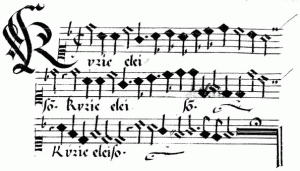![]() Guide: Vocal Music in the Medieval and Renaissance Periods
Guide: Vocal Music in the Medieval and Renaissance Periods
The term polyphony can be used to describe a general style of music from the Medieval and Renaissance periods or, more broadly, to refer to any musical texture of more than one distinct, simultaneous melodic lines.
Polyphony emerged out of Medieval church music (chant) around the 12th century with the invention of organum (the earliest named composers of organum were Leonin and Perotin, both working at Notre Dame in Paris).
This form of music reached the peak of its popularity and sophistication in the Renaissance in the 16th century (Palestrina and Lassus, aka Lasso, are considered the defining composers of that period).
Polyphony may be found in motets, masses, and madrigals, the dominant genres of vocal ensemble music during the 14th-16th centuries.
What to listen for in Renaissance polyphony:
- Polyphony utilizes mostly contrapuntal textures (often mixed with short passages of homophony, in which all the voices sing in the same rhythm but with different pitches), rather than melody-and-accompaniment type of textures (what we think of as “song”).
- Each of the different voices have equal importance in the overall sound of the music. (This is in contrast to monophony, in which there is one melody which performers would sing simultaneously.)
- Polyphony often involves canon, a compositional technique utilizing imitative counterpoint, where two or more voices perform the same, or very similar, melodies in a sequence of overlapping entrances. (Think “Row, Row, Row Your Boat.”) Sometimes the melodies are transposed (i.e. starting on a different pitch) or otherwise altered.
- The harmonic system used in this music was derived from the church modes (see chant for more info) and therefore sounds noticeably different from the tonal music of the Baroque and Classical periods.
Recommended listening:
See organum to hear the very earliest polyphony, which is stylistically and technically different than this later music.
Late Medieval polyphony:
- Messe de Nostre Dame, Machaut [YouTube] French, composed before 1365 (exact date unknown).
- Missa L’homme arme, Dufay [YouTube] Franco-Flemish, composed mid-1400s (exact date unknown).
Renaissance polyphony:
- Missa pro defunctis, Lassus [YouTube] Franco-Flemish, composed 1577.
- Missae Papae Marcelli, Palestrina [YouTube] Italian, composed 1567.
